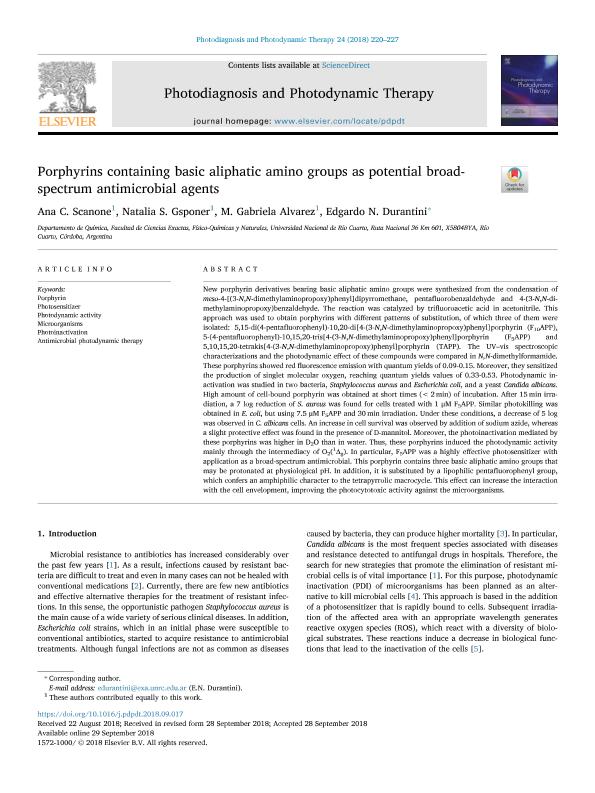Mostrar el registro sencillo del ítem
dc.contributor.author
Scanone, Ana Coral

dc.contributor.author
Gsponer, Natalia Soledad

dc.contributor.author
Alvarez, María Gabriela

dc.contributor.author
Durantini, Edgardo Néstor

dc.date.available
2020-03-20T20:44:12Z
dc.date.issued
2018-12
dc.identifier.citation
Scanone, Ana Coral; Gsponer, Natalia Soledad; Alvarez, María Gabriela; Durantini, Edgardo Néstor; Porphyrins containing basic aliphatic amino groups as potential broad-spectrum antimicrobial agents; Elsevier Science; Photodiagnosis Photodynamic Therapy; 24; 12-2018; 220-227
dc.identifier.issn
1572-1000
dc.identifier.uri
http://hdl.handle.net/11336/100531
dc.description.abstract
New porphyrin derivatives bearing basic aliphatic amino groups were synthesized from the condensation of meso-4-[(3-N,N-dimethylaminopropoxy)phenyl]dipyrromethane, pentafluorobenzaldehyde and 4-(3-N,N-dimethylaminopropoxy)benzaldehyde. The reaction was catalyzed by trifluoroacetic acid in acetonitrile. This approach was used to obtain porphyrins with different patterns of substitution, of which three of them were isolated: 5,15-di(4-pentafluorophenyl)-10,20-di[4-(3-N,N-dimethylaminopropoxy)phenyl]porphyrin (F10APP), 5-(4-pentafluorophenyl)-10,15,20-tris[4-(3-N,N-dimethylaminopropoxy)phenyl]porphyrin (F5APP) and 5,10,15,20-tetrakis[4-(3-N,N-dimethylaminopropoxy)phenyl]porphyrin (TAPP). The UV–vis spectroscopic characterizations and the photodynamic effect of these compounds were compared in N,N-dimethylformamide. These porphyrins showed red fluorescence emission with quantum yields of 0.09-0.15. Moreover, they sensitized the production of singlet molecular oxygen, reaching quantum yields values of 0.33-0.53. Photodynamic inactivation was studied in two bacteria, Staphylococcus aureus and Escherichia coli, and a yeast Candida albicans. High amount of cell-bound porphyrin was obtained at short times (<2 min) of incubation. After 15 min irradiation, a 7 log reduction of S. aureus was found for cells treated with 1 μM F5APP. Similar photokilling was obtained in E. coli, but using 7.5 μM F5APP and 30 min irradiation. Under these conditions, a decrease of 5 log was observed in C. albicans cells. An increase in cell survival was observed by addition of sodium azide, whereas a slight protective effect was found in the presence of D-mannitol. Moreover, the photoinactivation mediated by these porphyrins was higher in D2O than in water. Thus, these porphyrins induced the photodynamic activity mainly through the intermediacy of O2(1Δg). In particular, F5APP was a highly effective photosensitizer with application as a broad-spectrum antimicrobial. This porphyrin contains three basic aliphatic amino groups that may be protonated at physiological pH. In addition, it is substituted by a lipophilic pentafluorophenyl group, which confers an amphiphilic character to the tetrapyrrolic macrocycle. This effect can increase the interaction with the cell envelopment, improving the photocytotoxic activity against the microorganisms.
dc.format
application/pdf
dc.language.iso
eng
dc.publisher
Elsevier Science

dc.rights
info:eu-repo/semantics/openAccess
dc.rights.uri
https://creativecommons.org/licenses/by-nc-sa/2.5/ar/
dc.subject
ANTIMICROBIAL PHOTODYNAMIC THERAPY
dc.subject
MICROORGANISMS
dc.subject
PHOTODYNAMIC ACTIVITY
dc.subject
PHOTOINACTIVATION
dc.subject
PHOTOSENSITIZER
dc.subject
PORPHYRIN
dc.subject.classification
Química Orgánica

dc.subject.classification
Ciencias Químicas

dc.subject.classification
CIENCIAS NATURALES Y EXACTAS

dc.title
Porphyrins containing basic aliphatic amino groups as potential broad-spectrum antimicrobial agents
dc.type
info:eu-repo/semantics/article
dc.type
info:ar-repo/semantics/artículo
dc.type
info:eu-repo/semantics/publishedVersion
dc.date.updated
2020-03-13T18:08:36Z
dc.journal.volume
24
dc.journal.pagination
220-227
dc.journal.pais
Países Bajos

dc.journal.ciudad
Amsterdam
dc.description.fil
Fil: Scanone, Ana Coral. Universidad Nacional de Río Cuarto. Facultad de Ciencias Exactas Fisicoquímicas y Naturales. Departamento de Química; Argentina. Consejo Nacional de Investigaciones Científicas y Técnicas. Centro Científico Tecnológico Conicet - Córdoba; Argentina
dc.description.fil
Fil: Gsponer, Natalia Soledad. Consejo Nacional de Investigaciones Científicas y Técnicas. Centro Científico Tecnológico Conicet - Córdoba; Argentina. Universidad Nacional de Río Cuarto. Facultad de Ciencias Exactas Fisicoquímicas y Naturales. Departamento de Química; Argentina
dc.description.fil
Fil: Alvarez, María Gabriela. Universidad Nacional de Río Cuarto. Facultad de Ciencias Exactas Fisicoquímicas y Naturales. Departamento de Química; Argentina. Consejo Nacional de Investigaciones Científicas y Técnicas. Centro Científico Tecnológico Conicet - Córdoba; Argentina
dc.description.fil
Fil: Durantini, Edgardo Néstor. Consejo Nacional de Investigaciones Científicas y Técnicas. Centro Científico Tecnológico Conicet - Córdoba; Argentina. Universidad Nacional de Río Cuarto. Facultad de Ciencias Exactas Fisicoquímicas y Naturales. Departamento de Química; Argentina
dc.journal.title
Photodiagnosis Photodynamic Therapy

dc.relation.alternativeid
info:eu-repo/semantics/altIdentifier/doi/https://doi.org/10.1016/j.pdpdt.2018.09.017
dc.relation.alternativeid
info:eu-repo/semantics/altIdentifier/url/https://www.sciencedirect.com/science/article/abs/pii/S1572100018302734
Archivos asociados
